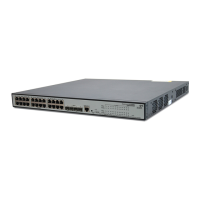185
MSTP
STP and RSTP limitations
STP does not support rapid state transition of ports. A newly elected port must wait twice the forward delay
time before transiting to the forwarding state, even if it connects to a point-to-point link or is an edge port.
Although RSTP supports rapid network convergence, it has the same drawback as STP—All bridges within
a LAN share the same spanning tree, so redundant links cannot be blocked based on VLAN, and the
packets of all VLANs are forwarded along the same spanning tree.
MSTP features
Developed based on IEEE 802.1s, MSTP overcomes the shortcomings of STP and RSTP. In addition to
supporting for rapid network convergence, it also provides a better load sharing mechanism for redundant
links by allowing data flows of different VLANs to be forwarded along separate paths.
MSTP includes the following features:
MSTP supports mapping VLANs to MST instances (MSTIs) by means of a VLAN-to-MSTI mapping table.
MSTP can reduce communication overheads and resource usage by mapping multiple VLANs to one
MSTI.
MSTP divides a switched network into multiple regions, each containing multiple spanning trees that
are independent of one another.
MSTP prunes a loop network into a loop-free tree, avoiding proliferation and endless cycling of
packets in a loop network. In addition, it provides multiple redundant paths for data forwarding,
supporting load balancing of VLAN data.
MSTP is compatible with STP and RSTP.
MSTP basic concepts
Assume that all the four devices in a are running MSTP. This section explains some basic concepts of MSTP
based on the figure.

